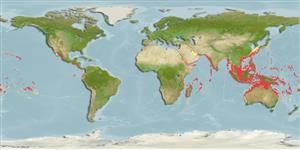>
Carangiformes (Jacks) >
Carangidae (Jacks and pompanos) > Caranginae
Etymology: Caranx: French, carangue, the name of a Caribbean fish; 1836 (Ref. 45335).
More on author: Cuvier.
Environment: milieu / climate zone / depth range / distribution range
Ecologia
marinhas; estuarina associadas(os) a recifes; intervalo de profundidade 0 - 190 m (Ref. 9710). Tropical; 35°N - 35°S, 30°E - 78°W
Indo-Pacific: Red Sea and East Africa to Ducie Island, north to the Ryukyu Islands, south to New Caledonia. Eastern Central Pacific: Mexico to Panama (Ref. 9283). Hybrid with Caranx sexfasciatus found in Hawaii (Ref. 58422).
Length at first maturity / Tamanho / Peso / Idade
Maturity: Lm 35.0 range ? - ? cm
Max length : 117 cm FL macho/indeterminado; (Ref. 40637); common length : 60.0 cm TL macho/indeterminado; (Ref. 3280); peso máx. Publicado: 43.5 kg (Ref. 4699)
Espinhos dorsais (total) : 9; Raios dorsais moles (total) : 21 - 24; Espinhos anais: 3; Raios anais moles: 17 - 21; Vértebras: 24. This species is distinguished by the following characters: gill rakers (including rudiments) 5-9 + 17-21 = 25-29 (usually 26-27); breast completely scaly; straight part of lateral line with 0-10 anterior scales followed by 27-42 strong scutes; adipose eyelid weakly developed, small anteriorly, posterior adipose eyelid extends onto eye to rear border of pupil in large adults; upper jaw with outer row of strong canines widely spaced in adults, and an inner band of small villiform teeth, widest at symphysis; lower limb of first gill arch jaw with a single row of strong
conical teeth widely spaced in adults. Colour of adults with head and dorsal half of body brassy, suffused with blue, and covered with small blue black spots (forming at about 16 to 22 cm fork length and increasing in number with size); second dorsal, anal, and caudal fins electric blue; juveniles and young adults, head and body silvery grey and fins pale to dark dusky, except pectoral fins yellow (Ref. 9894, 90102).
The most common trevally in coral reefs occurring singly or occasionally in schools (Ref. 90102). Adults are pelagic in coastal and oceanic waters, associated with reefs (Ref. 9283, 58302). Juveniles occur seasonally in shallow sandy inshore waters (Ref. 9710) and rivers (Ref. 12792). Adults feed mainly on other fishes (Ref. 9283) and crustaceans (Ref. 9710). They are often toxic when length reaches more than 50 cm (Ref. 4795). Mainly marketed fresh, but also dried or salted (Ref. 9283). They are caught primarily on hook-and-line and by spearing; also with traps and gill nets. An excellent sports fish (Ref. 9894).
Paxton, J.R., D.F. Hoese, G.R. Allen and J.E. Hanley, 1989. Pisces. Petromyzontidae to Carangidae. Zoological Catalogue of Australia, Vol. 7. Australian Government Publishing Service, Canberra, 665 p. (Ref. 7300)
Categoria na Lista Vermelha da IUCN (Ref. 130435: Version 2024-1)
Ameaça para o homem
Reports of ciguatera poisoning (Ref. 4690)
Utilização humana
Pescarias: espécies comerciais; Aquacultura: espécies comerciais; peixe desportivo: sim; Aquário: Aquários públicos
Ferramentas
Relatórios especiais
Descarregue XML
Fontes da internet
Estimates based on models
Preferred temperature (Ref.
123201): 23.2 - 29, mean 27.9 °C (based on 2624 cells).
Phylogenetic diversity index (Ref.
82804): PD
50 = 0.5000 [Uniqueness, from 0.5 = low to 2.0 = high].
Bayesian length-weight: a=0.01738 (0.01434 - 0.02105), b=2.96 (2.93 - 2.99), in cm total length, based on LWR estimates for this species (Ref.
93245).
Nível Trófico (Ref.
69278): 4.5 ±0.8 se; based on diet studies.
Resiliência (Ref.
120179): Médio, tempo mínimo de duplicação da população 1,4 - 4,4 anos (K=0.23; tm=2; Fec=49,700).
Prior r = 0.69, 95% CL = 0.45 - 1.03, Based on 3 data-limited stock assessments.
Fishing Vulnerability (Ref.
59153): High vulnerability (59 of 100).
Climate Vulnerability (Ref.
125649): High to very high vulnerability (75 of 100).
Nutrients (Ref.
124155): Calcium = 14.7 [6.6, 29.0] mg/100g; Iron = 0.319 [0.174, 0.619] mg/100g; Protein = 20.3 [18.0, 22.7] %; Omega3 = 0.142 [0.084, 0.238] g/100g; Selenium = 56.3 [27.9, 115.0] μg/100g; VitaminA = 62.9 [18.4, 209.2] μg/100g; Zinc = 0.451 [0.325, 0.642] mg/100g (wet weight); based on
nutrient studies.
